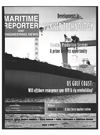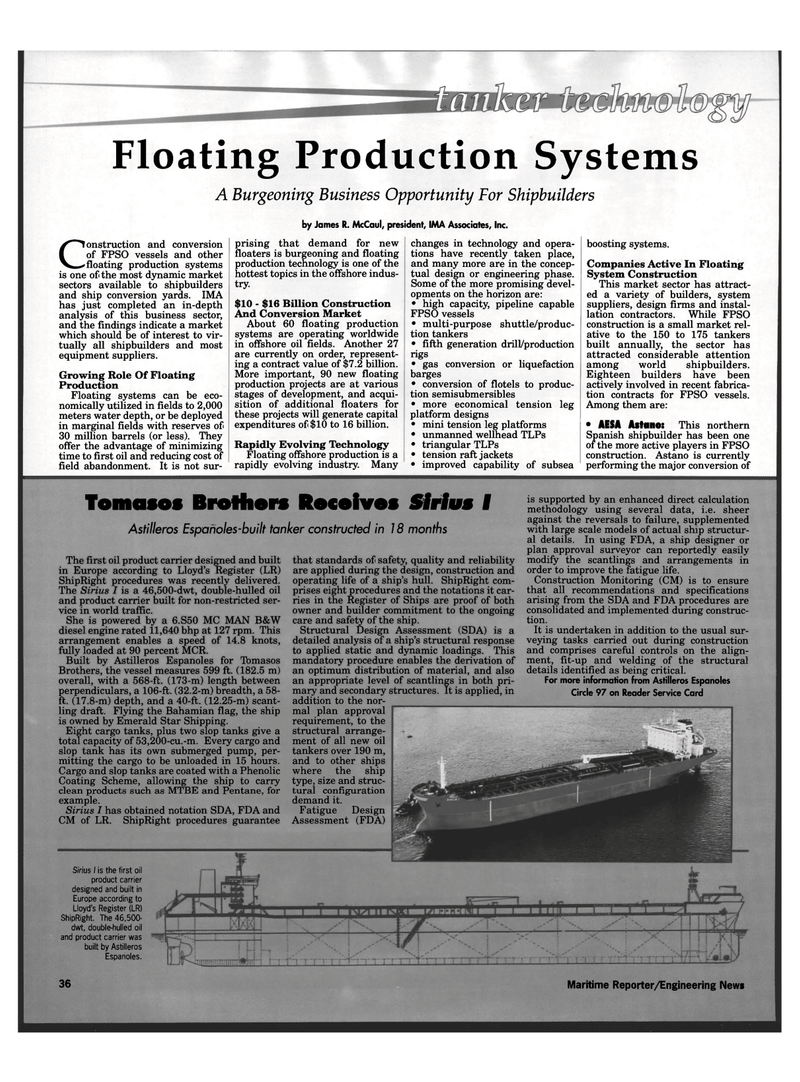
Page 34: of Maritime Reporter Magazine (May 1996)
Read this page in Pdf, Flash or Html5 edition of May 1996 Maritime Reporter Magazine
Floating Production Systems
A Burgeoning Business Opportunity For Shipbuilders
Construction and conversion of FPSO vessels and other floating production systems is one of the most dynamic market sectors available to shipbuilders and ship conversion yards. IMA has just completed an in-depth analysis of this business sector, and the findings indicate a market which should be of interest to vir- tually all shipbuilders and most equipment suppliers.
Growing Role Of Floating
Production
Floating systems can be eco- nomically utilized in fields to 2,000 meters water depth, or be deployed in marginal fields with reserves of 30 million barrels (or less). They offer the advantage of minimizing time to first oil and reducing cost of field abandonment. It is not sur- by James R. McCaul, president, IMA Associates, Inc. prising that demand for new floaters is burgeoning and floating production technology is one of the hottest topics in the offshore indus- try. $10 - $16 Billion Construction
And Conversion Market
About 60 floating production systems are operating worldwide in offshore oil fields. Another 27 are currently on order, represent- ing a contract value of $7.2 billion.
More important, 90 new floating production projects are at various stages of development, and acqui- sition of additional floaters for these projects will generate capital expenditures of $10 to 16 billion.
Rapidly Evolving Technology
Floating offshore production is a rapidly evolving industry. Many changes in technology and opera- tions have recently taken place, and many more are in the concep- tual design or engineering phase.
Some of the more promising devel- opments on the horizon are: • high capacity, pipeline capable
FPSO vessels • multi-purpose shuttle/produc- tion tankers • fifth generation drill/production rigs • gas conversion or liquefaction barges • conversion of Hotels to produc- tion semisubmersibles • more economical tension leg platform designs • mini tension leg platforms • unmanned wellhead TLPs • triangular TLPs • tension raft jackets • improved capability of subsea boosting systems.
Companies Active In Floating
System Construction
This market sector has attract- ed a variety of builders, system suppliers, design firms and instal- lation contractors. While FPSO construction is a small market rel- ative to the 150 to 175 tankers built annually, the sector has attracted considerable attention among world shipbuilders.
Eighteen builders have been actively involved in recent fabrica- tion contracts for FPSO vessels.
Among them are: • AESA Astano: This northern
Spanish shipbuilder has been one of the more active players in FPSO construction. Astano is currently performing the major conversion of 36 Maritime Reporter/Engineering News is supported by an enhanced direct calculation methodology using several data, i.e. sheer against the reversals to failure, supplemented with large scale models of actual ship structur- al details. In using FDA, a ship designer or plan approval surveyor can reportedly easily modify the scantlings and arrangements in order to improve the fatigue life.
Construction Monitoring (CM) is to ensure that all recommendations and specifications arising from the SDA and FDA procedures are consolidated and implemented during construc- tion.
It is undertaken in addition to the usual sur- veying tasks carried out during construction and comprises careful controls on the align- ment, fit-up and welding of the structural details identified as being critical.
For more information from Astilleros Espanoles
Circle 97 on Reader Service Card
Sirius I is the first oil product carrier designed and built in
Europe according to
Lloyd's Register (LR)
ShipRight. The 46,500- dwt, double-hulled oil and product carrier was built by Astilleros
Espanoles.
Tomasos Brothers Receives Sirius f
Astilleros Espanoles-built tanker constructed in 18 months
The first oil product carrier designed and built in Europe according to Lloyd's Register (LR)
ShipRight procedures was recently delivered.
The Sirius I is a 46,500-dwt, double-hulled oil and product carrier built for non-restricted ser- vice in world traffic.
She is powered by a 6.S50 MC MAN B&W diesel engine rated 11,640 bhp at 127 rpm. This arrangement enables a speed of 14.8 knots, fully loaded at 90 percent MCR.
Built by Astilleros Espanoles for Tomasos
Brothers, the vessel measures 599 ft. (182.5 m) overall, with a 568-ft. (173-m) length between perpendiculars, a 106-ft. (32.2-m) breadth, a 58- ft. (17.8-m) depth, and a 40-ft. (12.25-m) scant- ling draft. Flying the Bahamian flag, the ship is owned by Emerald Star Shipping.
Eight cargo tanks, plus two slop tanks give a total capacity of 53,200-cu.-m. Every cargo and slop tank has its own submerged pump, per- mitting the cargo to be unloaded in 15 hours.
Cargo and slop tanks are coated with a Phenolic
Coating Scheme, allowing the ship to carry clean products such as MTBE and Pentane, for example.
Sirius I has obtained notation SDA, FDA and
CM of LR. ShipRight procedures guarantee that standards of safety, quality and reliability are applied during the design, construction and operating life of a ship's hull. ShipRight com- prises eight procedures and the notations it car- ries in the Register of Ships are proof of both owner and builder commitment to the ongoing care and safety of the ship.
Structural Design Assessment (SDA) is a detailed analysis of a ship's structural response to applied static and dynamic loadings. This mandatory procedure enables the derivation of an optimum distribution of material, and also an appropriate level of scantlings in both pri- mary and secondary structures. It is applied, in addition to the nor- mal plan approval requirement, to the structural arrange- ment of all new oil tankers over 190 m, and to other ships where the ship type, size and struc- tural configuration demand it.
Fatigue Design
Assessment (FDA)

 33
33

 35
35
